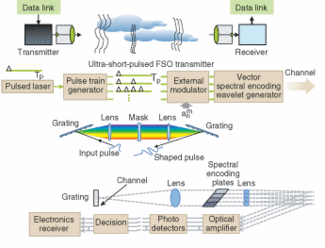FREE-SPACE OPTICS: Laser link offers fiber quality through cloud cover
Hassaun Jones-Bey
The dream of global communication at terabit speeds appears to have moved closer to reality. Researchers at The Pennsylvania State University (Penn State; University Park, PA) have developed signal-processing technology for free-space optics intended for communication through 8 to 10 km of cumulus clouds, all the while retaining fiber-optic signal quality.

Penn State researchers have coupled state-of-the-art digital signal-processing methods to a free-space laser-communications system intended to achieve fiber-optic signal quality through 8 to 10 km of cumulus clouds at gigabit data rates.
“Radio-frequency communications are generally reliable and well understood, but cannot support emerging data-rate needs unless they use a large portion of the radio spectrum,” said Mohsen Kavehrad, the W. L. Weiss professor of electrical engineering and director, Penn State Center for Information and Communications Technology Research. “The Air Force, which is funding this project through the Defense Advanced Research Projects Agency (DARPA; Arlington, VA), would like us to deliver close to three gigabytes per second of data over a distance of six to eight miles through the atmosphere.”
The potential for achieving such data rates with free-space optics has been traditionally limited by atmospheric clouds, fog, dust, dirt, water vapor, and gases that potentially disperse optical beams, thereby causing so-called “intersymbol interference,” in which each symbol within an optically transmitted message gets spread over many pulses and arrives at the receiver in numerous distorted fragments, somewhat like echoes in a canyon. Kavehrad and Sangwoo Lee, a graduate student in electrical engineering, presented an electronic signal-processing solution to this problem at the IEEE Military Communications Conference, held in Washington, D.C., last October.
“In the past, laser-communication systems have been designed to depend on optical signal processing and optical apparatus,” Kavehrad said. “We can make an optical equalizer on paper now, but have no clue as to when it might actually be possible to make a physical one. So we coupled state-of-the-art digital signal-processing methods to a wireless laser-communications system to obtain a reliable, high-capacity optical link through the clouds. If you don’t limit yourself religiously to the words ‘all-optical’ and consider electro-optical as well, there is a lot that can be accomplished.”
Signal processing
The Penn State approach uses proven signal-processing technology and off-the-shelf equipment. The basic algorithm, maximum likelihood sequence detection (MLSD), dates back to the 1950s and, in principle, offers the most accurate results. Instead of detecting symbols one at a time on arrival, MLSD involves writing the length of a communication channel into memory and then processing the entire sequence.
“When you are detecting one symbol at a time, overlap in adjacent symbols is considered the enemy,” Kavehrad said. “Overlap becomes useful if you wait, however, because MLSD can reconstruct more-accurate symbols by simultaneously using all of the information stretched over numerous adjacent pulses.”
The number of calculations quickly becomes unwieldy, even with modern computing technology, because multigigabit data rates yield nanosecond-wide symbols. And in any channel where there is dispersion, even in fiber, the symbols are stretched over many pulses. So the trickis to artificially shorten the channel. “Instead of 150 symbols, you may only store 15 symbols upon which to do the estimate,” Kavehrad said. “It’s not quite as exact, but it makes an unrealizable problem realizable.”
In laboratory simulations of the technique Kavehrad’s team has achieved bit-error rates between 10-9 and 10-12. The technique won’t work through, for example, ground-fog distances of 200 km. But 8 to 10 km through cumulus-cloud layers should be plenty for the air-to-ground needs of the U.S. Air Force, he said. Among cloud types, cumulus presents the largest optical-thickness values(scattering coefficient multiplied by the distance to be traveled), because they occupy the lowest altitudes and therefore include atmospheric dirt in addition to water droplets.
Optical-signal dispersion in 8 to 10 km of cumulus clouds falls within the Mie regime, in which scattering tends to be longitudinally directed along the line of beam travel. Larger optical paths are associated with Rayleigh scattering, which is omnidirectional and much more computationally intensive.
Currently, DARPA is funding implementation and technology-maturation phases of the project in parallel. Lockheed Martin (Akron, OH) is building a link, for the implementation phase, across 54 miles of New Mexico desert (not through cloud cover). Researchers at Penn State and at Teledyne Scientific and Imaging (Thousand Oaks, CA) are developing air-to-ground systems that will actually communicate through clouds. A U.S. Army project involves communicating to and from a tank through the oil-fog and smoke emitted from the tank’s smoke generator.
Because the Penn State approach provides fiber-optic-quality signals, it also offers a potential alternative for extending fiber-optic systems to rural areas without laying cable and may eventually expand the Internet in a third dimension, allowing airplane passengers a clear, continuous signal, according to Kavehrad. The ultimate military goal, however, is the capability for terabit data speeds between Earth and airplanes and orbiting satellites.
“Global communication at terabit speeds has to have free-space optics,” Kavehrad said. “There is no other way to get terabits to a plane. You can’t run a fiber to it. It would be nice, but you can’t do it.”
Hassaun A. Jones-Bey
featured webcasts
Ultrafast 2-D Vibrational Echo Experiments with Applications in Chemistry and Biology
Original broadcast on
April 26, 2007
White Papers
White Paper Categories:
| General |
Instrumentation
and Accessories |
| Lasers
and Sources |
Optics |


 e-newsletter
e-newsletter magazines
magazines














